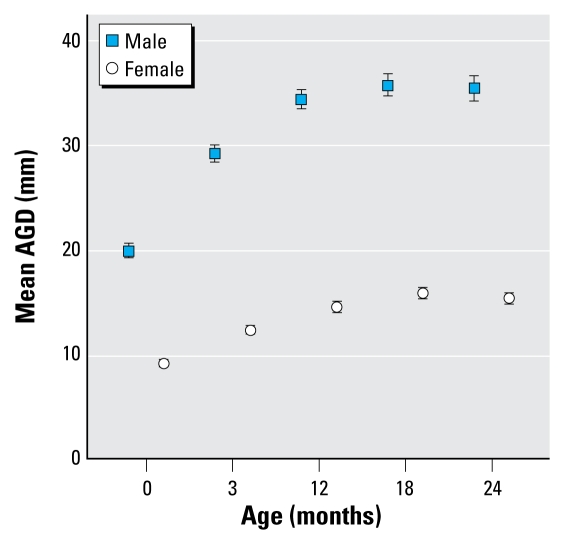File:Anogenital distance from birth to 2 years.jpg
Anogenital_distance_from_birth_to_2_years.jpg (565 × 545 pixels, file size: 34 KB, MIME type: image/jpeg)
Anogenital Distance from Birth to Two Years
Mean ± 95% CI Anogenital Distance (AGD) measurements in males and females from birth to 2 years of age.
This study confirms sexual dimorphism of AGD at birth that was maintained to the same degree during the first 2 years of life. In males, AGD was related to penile length and penile growth and hence may be useful as a marker of androgen action.
Original file name: Figure 2 http://www.ncbi.nlm.nih.gov/pmc/articles/PMC2801188/figure/f2-ehp-117-1786/
BACKGROUND: Anogenital distance (AGD) is sexually dimorphic in rodents and humans, being 2- to 2.5-fold greater in males. It is a reliable marker of androgen and antiandrogen effects in rodent reproductive toxicologic studies. Data on AGD in humans are sparse, with no longitudinal data collected during infancy.
OBJECTIVE: This study was designed to determine AGD from birth to 2 years in males and females and relate this to other anthropometric measures.
MATERIALS AND METHODS: Infants were recruited from the Cambridge Baby Growth Study. AGD was measured from the center of the anus to the base of the scrotum in males and to the posterior fourchette in females. Measurements were performed at birth and at 3, 12, 18, and 24 months of age.
RESULTS: Data included 2,168 longitudinal AGD measurements from 463 male and 426 female full-term infants (median = 2 measurements per infant). Mean AGD (+/- SD) at birth was 19.8 +/- 6.1 mm in males and 9.1 +/- 2.8 mm in females (p < 0.0001). AGD increased up to 12 months in both sexes and in a sex-dimorphic pattern. AGD was positively correlated with penile length at birth (r = 0.18, p = 0.003) and the increase in AGD from birth to 3 months was correlated with penile growth (r = 0.20, p = 0.001).
CONCLUSION: We report novel, longitudinal data for AGD during infancy in a large U.K. birth cohort. AGD was sex dimorphic at all ages studied. The availability of normative data provides a means of utilizing this biological marker of androgen action in population studies of the effects of environmental chemicals on genital development.
Reference
<pubmed>20049133</pubmed>| PMC2801188
Environ Health Perspect. 2009 November; 117(11): 1786–1790.
Published online 2009 July 13. doi: 10.1289/ehp.0900881.
Copyright This is an Open Access article: verbatim copying and redistribution of this article are permitted in all media for any purpose, provided this notice is preserved along with the article's original DOI.
File history
Click on a date/time to view the file as it appeared at that time.
| Date/Time | Thumbnail | Dimensions | User | Comment | |
|---|---|---|---|---|---|
| current | 16:56, 23 October 2010 |  | 565 × 545 (34 KB) | S8600021 (talk | contribs) | ==Anogenital Distance from Birth to Two Years== Mean ± 95% CI AGD measurements in males and females from birth to 2 years of age. Original file name: Figure 2 BACKGROUND: Anogenital distance (AGD) is sexually dimorphic in rodents and humans, being 2- |
You cannot overwrite this file.
File usage
There are no pages that use this file.
